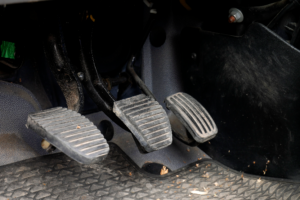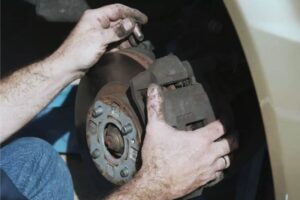Driving a car that emits blue smoke from its exhaust can be embarrassing. If you don’t want to get embarrassed like this, you need the information in this article about blue smoke from exhaust causes and how to fix it.
Blue smoke from the exhaust is commonly caused by oil leaking from the engine seals and going into the cylinders where the fuel is. This leaked oil mixes with the fuel and burns with it. That produces blue smoke. When this happens at startup, it could mean worn valve guides or worn piston seals.
Fixing the cause of the oil leaks will stop this blue smoke from coming out of the exhaust pipe. So, if the oil leak is coming from a damaged head gasket, it may entail too much work, but you have to replace it.
More serious damage to your engine will result if you don’t stop this oil and fuel mixture from burning inside the combustion chamber.
Read on to learn more about blue smoke coming from your exhaust pipe, the possible causes, and their respective fixes.
Blue Smoke From Exhaust
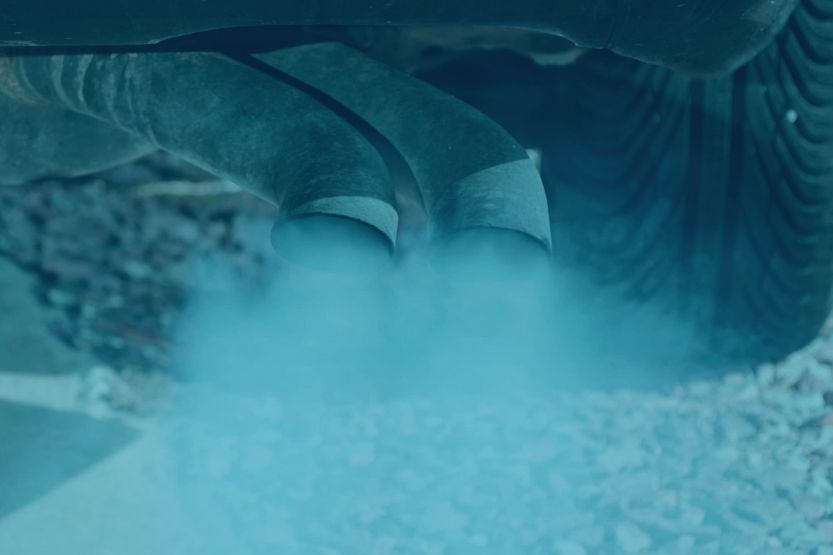
Oil Leak Past the Engine Seals
What does blue smoke from the exhaust mean? One of the significant reasons for blue smoke in the exhaust is oil leaking past the engine seals. This oil seeps into the cylinders, mixing and burning with the fuel.
Damaged Valve Guides or Piston Seals
You have damaged valve guides or piston seals when you see blue smoke from the exhaust on startup. If this is the condition of your engine, you will also hear some rattling noises.
Replace Worn-out Seals and Valve Guides
Fixing this issue requires the replacement of worn-out seals and valve guides. If a damaged head gasket causes the problem, you need to replace it.
Head Gasket Repair
Head gasket repair is the first fix you need to consider when your car emits blue smoke on the tailpipe. You should perform this repair if you don’t want any more severe damage happening to your engine.
White Smoke from Exhaust When Accelerating – What to Do
How to Fix Blue Smoke from Exhaust Issue: A Brief Rundown
There is a procedure that car mechanics perform to fix this blue smoke problem. Here is a brief rundown of this procedure:
- Get out all the excess oil in the system.
- Clean the engine. If it’s been a long time since you’ve done this, perhaps it’s about time you have it done.
- Replace the piston rings
- Clean or repair the turbocharger
- Replace the PCV Valve
- Repair or replace the valve seals.
Average Cost
The cost of this fix can range from $80 in a car repair shop. The labor part of the fix takes much of the cost. This is about $500 plus. It is that expensive, but that’s better than spending thousands of dollars to repair a damaged engine or even buy a new one.
Burning of Oil and Fuel
Blue smoke is the product of the burning of oil and fuel during the combustion cycles inside the engine’s cylinders. Fuel and air are supposedly the only substances allowed to enter the cylinders.
Oil can seep inside the cylinder and mix with fuel if there is a leak somewhere in the lubrication system. Blue smoke will result when the fuel/air and oil mixture is burned.
Blue Smoke When Accelerating
When accelerating, blue smoke from the exhaust could signify a bad PCV valve, a failing turbocharger, a damaged head gasket, and worn-out seals. You will commonly see this blue smoke from the exhaust when starting your engine in the morning.
Immediately Visit a Mechanic
Don’t wait for more serious damage to happen to your engine. You need to have this problem fixed right away. If not, the problem could escalate to such an extent that you may have to rebuild your engine. And that’s much more expensive than doing the appropriate repairs now.
Causes of Blue Smoke
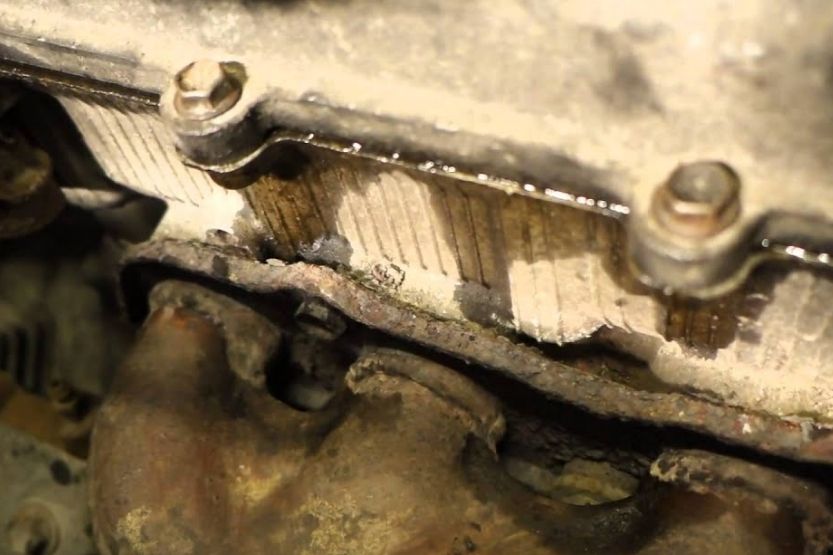
What causes the blue smoke from exhaust? You need to know these causes, so you can prevent them before the problem gets more serious:
1. Oil Leaks Into the Cylinders
If your car has already run its thousands of miles, its engine will show specific signs of aging and stress. The following parts will show signs of age:
- Valve seals,
- Piston rings, and
- Other engine components.
The deterioration rate of these engine parts will be faster if you are not religious in performing regular preventive maintenance, such as regular change oils.
Brittle Valve Seals
Over time and under stress, valve seals will get brittle and crack. They won’t be able to keep a tight seal between the oil and the fuel. When that happens, the oil will begin to mix with the fuel. Both will be introduced inside the combustion chamber.
Fuel and Oil Mixture Burn Together
When ignition fires up, fuel and oil mixture will burn together. What comes out of your tailpipe is blue smoke.
2. Worn or Damaged Piston Rings
Piston rings’ function is to keep the lubricating engine oil properly. However, when damaged, they cannot perform their job properly. So, the engine oil can seep into the cylinders.
Once the oil is inside the cylinders, it mixes with the fuel and air. When the spark plug ignites the air/fuel mixture, the oil also burns with this mixture. Then you get blue smoke coming out of your tailpipe.
3. Blown Turbocharger
Turbochargers can blow out, especially if they are already past their lifetime. But this can also happen in new turbochargers with defects. The engine will also produce blue smoke if you have a blown-out turbocharger.
4. Stuck PCV Valve
While the engine is running, pressure can build in the oil located in the oil pan. You must release this pressure build-up from time to time.
The PCV valve or the positive crankcase ventilation valve handles this task. The excess pressure is channeled to the intake manifold so the fumes or gases can be burned again in the combustion chambers.
But, if the PCV valve is stuck, it allows oil to mix with the gases and the air. Since the intake manifold is also connected to the air filter, this will result in blue smoke.
5. Worn Out or Damaged Oil Seal
Oil seals in the engine also prevent lubricating oil from seeping into engine parts. Over time and under stress, these rubber seals will get brittle and crack.
When that happens, they will not be able to prevent oil from going inside engine parts where they are not supposed to go, resulting in blue smoke out of your exhaust pipe.
6. Dripping Oil
Indication of Leaking Lubricating Oil
If you notice the dripping of oil in your car, it is an indication that lubricating oil is leaking somewhere in some part of the engine. It is also possible that the dripping oil is making contact with some engine parts running hot under the hood.
Leaking Oil Touching the Engine Block
As you step on the gas, you may notice blue smoke coming from the back of your car. This can be due to the leaking oil striking the engine block. It may seem like this blue smoke is coming from the exhaust, but it isn’t really.
Can Also Leak from a Blown Gasket
Oil can also leak from a blown gasket inside the engine block. As the oil leaks, it can travel onto the exhaust and cause blue smoke. Oil can also leak into the engine’s headers, causing blue smoke.
If it is under the hood where the blue smoke seems to come from when the car isn’t running, it’s an indication that there’s an oil leak somewhere. If the oil leaks from the head gasket, you may need to replace the cylinder head.
7. Damaged Glow Plugs
Blue Smoke from the Car’s Rear
If a diesel engine powers your car and there’s blue smoke coming out on your rear when you start your car, it is a sign that the engine’s glow plugs have gone bad. You won’t be able to start your car generally as before. Your usual cranking time may also get longer.
How to Check If You Have Damaged Glow Plugs
To check if your glow plugs are causing the problem, connect a 12 –volt test light to the positive terminal of your car battery. And then connect the wire to each glow wire and see which one will get a reading.
Glow Plug Replacement Cost
Replacing the glow plugs can cost you from $100 to $500. If you ask a car repair shop to do it, it will be costly. But if you know how to do it yourself, you can save on the labor costs. Since glow plugs are expensive, be sure that they are no longer working before you try to replace them.
Effect of Oil Leak into the Engine Cylinders
If oil leaks into the engine cylinders, it will cause:
- Misfires,
- Rough idle,
- Failing spark plugs,
- Loss of power in your engine, and
- Low oil level.
Effect of Clogged Oil Filter
If you have a clogged oil filter, or the PCV valve or the air filter is not functioning properly, engine blow-by can result in loss of engine oil and, eventually, blue smoke.
You need to check your engine oil regularly and see if its level is not decreasing. If it is, oil could be leaking somewhere in your car’s lubrication system.
Use a Higher Viscosity Engine Oil
You can reduce the amount of blow-by by using higher viscosity engine oil. However, experts do not recommend this for the long term. If you are experiencing blue smoke in your tailpipe, you should have an ASE-certified mechanic check your car.
Again, what causes blue smoke from exhaust? A cloud of blue smoke from the exhaust might be due to an oil leak wherein the engine is burning the oil. Additionally, the leak is an effect of faulty valve seals, damaged piston rings, or worn cylinder walls. Visit your local mechanic to have this issue fixed.
How to Fix Blue Smoke from Exhaust: Detailed Discussion
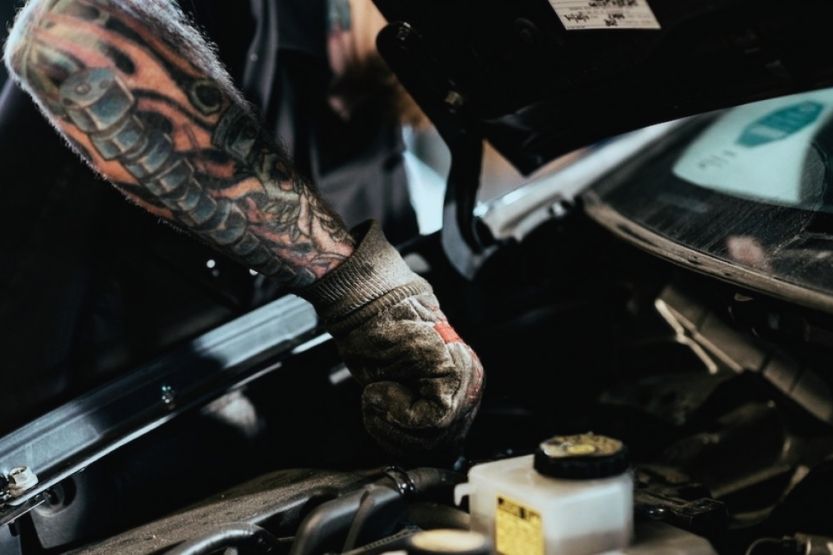
Now we come to the solution part of this article. Here is a detailed discussion of the steps to get rid of blue smoke from the exhaust:
1. Remove Excess Oil
Removing excess oil from your car’s lubrication system is the most straightforward fix you can perform to get rid of the blue smoke on your exhaust. However, this fix will only work if the blue smoke only appears after changing the oil in your car.
If there’s too much engine oil in the system, it will cause aeration and pressure build-up. This will make it more difficult for your engine to handle friction and heat. You can quickly correct the problem by removing excess oil and ensuring it is always at the right level.
2. Clean the Engine
An engine that hasn’t been cleaned for some time will develop problems. Dirt can get stuck inside the engine and will clog the return holes of the lubricating oil located in the cylinder head. This will lead to oil leaks. So, schedule engine clean-up at appropriate times.
To clean the engine, follow the steps below:
- Remove the valve cover and remove all the debris accumulated there.
- While you are at it, clean the drain back holes as well.
- Then wipe down the engine to ensure that no oil is left behind that can cause blue smoke later on.
- Since you are already cleaning the engine, thoroughly check it. Suppose there’s a spot where oil can leak, fix the issue right away. This is how to stop blue smoke on startup.
3. Replace the Piston Rings
Piston rings go up and down with the pistons inside the cylinders as the engine runs. The engine oil lubricates them. The oil will leak into the cylinder’s combustion chambers when these piston rings are damaged.
Oil will then be ignited with the fuel and air mixture when the spark plugs provide the spark-producing blue smoke on the exhaust. Damaged piston rings need to be replaced. But this is a tough job to do. So, this fix is very costly.
Cost of a Piston Ring
The cost of a piston ring is just about $50 each. However, it is the effort of removing the damaged ring and replacing it with a fresh one that is very difficult. So, the labor cost is hefty. First, the mechanic has to remove the engine from the car and disassembles it.
Piston Ring Repair Cost
This is the only way they can get to the piston rings. On average, expect to pay up to $1,000 or even more to have this kind of car repair. So, it’s essential to fix the blue smoke problem right before it gets serious.
4. Fix the Valve Seals
Fixing the valve seals is also a difficult task. It is better left with a car mechanic who knows what they are doing. They also have the right tools and skills to do a good job. The spring must be removed from the rocker arm and valve in replacing the valves.
Then the valve seal is lifted so it can be removed. After that, the new one is installed. The mechanic has to be very careful not to drop the valve into the engine. If they do, they will create a much bigger engine problem.
5. Fix the Turbocharger
A blown turbocharger also causes blue smoke to come out of your tailpipe. If you suspect that your turbocharger has blown, you should stop the car immediately. If you continue driving it, you are courting serious engine trouble.
The turbocharger is not lubricated. So, in the event of a blown turbocharger, tiny pieces of metal will detach from its structure and make their way into the engine. This can lead to severe damage to your engine.
6. Replace the PCV Valve
A PCV valve does not cost too much. And the job of replacing a damaged one is not that difficult. So, if you have identified a stuck PCV valve causing blue smoke on the exhaust, have it replaced right away.
Remove the valve and replace it with a new PCV valve. Just be sure that you mount the new one correctly so it can work well and solve your blue smoke problem.
Frequently Asked Questions
Here are some of the questions often asked by car owners who don’t know what blue smoke is. The answers to these questions will enlighten you more about this topic:
What Is That Blue Smoke from My Exhaust Pipe?
If you see blue smoke from your tailpipe, it will sometimes be accompanied by a burning smell. This indicates that there’s oil that enters the engine’s fuel system.
It gets burned with the fuel and air mixture. So, you get blue smoke on the exhaust. Engine oil is supposed to lubricate the engine parts and not be burned inside the combustion chambers.
Can I Still Drive My Car with Blue Smoke Coming Out of the Exhaust?
Yes, you can still drive your car. But since this thing shouldn’t happen, you should take your car to a reputable car mechanic so they can check it and recommend the right fix. If you don’t fix it immediately, it can lead to more serious and more expensive engine damage.
What Causes Blue Smoke from the Tailpipe?
The most common cause is engine oil getting into the engine’s combustion chambers. This is not supposed to happen. But if you are overfilling your engine oil, it can cause oil pressure build-up and leak afterward.
Conclusion: Blue Smoke From Exhaust
The majority of blue smoke from the exhaust is caused by oil leaks seeping past the engine seals, going into the cylinders, and mixing with fuel inside. The oil and the fuel and air mixture get burned together inside the combustion chambers, causing blue smoke to come out of the tailpipe.
If you see blue smoke when you start your engine, this can indicate worn valve guides or worn piston seals. Also, if it’s a damaged head gasket causing the oil leak, it needs to be replaced. If you don’t, more severe damage to the engine will result.
Read next:

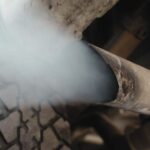
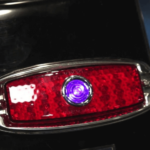

![Blue Headlights [Legal? Dangerous? Which Are Best?] blue headlights](https://roadsumo.com/wp-content/uploads/2022/06/blue-headlights-150x150.jpg)
![White Smoke On Startup Then Disappears [Causes and Solutions] White smoke On Startup Then Disappears](https://roadsumo.com/wp-content/uploads/2021/11/white-smoke-on-startup-then-disappears-150x150.jpg)

